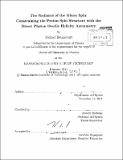| dc.contributor.advisor | Robert Redwine. | en_US |
| dc.contributor.author | Betancourt, Michael (Michael Joseph) | en_US |
| dc.contributor.other | Massachusetts Institute of Technology. Dept. of Physics. | en_US |
| dc.date.accessioned | 2013-03-01T15:11:41Z | |
| dc.date.available | 2013-03-01T15:11:41Z | |
| dc.date.copyright | 2011 | en_US |
| dc.date.issued | 2012 | en_US |
| dc.identifier.uri | http://hdl.handle.net/1721.1/77493 | |
| dc.description | Thesis (Ph. D.)--Massachusetts Institute of Technology, Dept. of Physics, February 2012. | en_US |
| dc.description | Cataloged from PDF version of thesis. | en_US |
| dc.description | Includes bibliographical references (p. 131-136). | en_US |
| dc.description.abstract | Although fundamental to the observable universe, the proton is not elementary. Rather the particle is a bound state of three valence quarks and the QCD vacuum that condenses around them, its properties an amalgamation of those underlying degrees of freedom. Naive expectations presume that contributions from the valence quarks dominate these properties, but the deep inelastic scattering (DIS) experiments which first investigated the proton structure in detail revealed the importance of the vacuum. In particular, polarized DIS measurements uncovered a surprisingly inadequate quark polarization, necessitating significant contributions to the proton spin from elsewhere. The total spin of the gluon field confining the quarks is one possibility, but a contribution only weakly constrained by the electromagnetic probes of DIS. An observable far more sensitive to contributions from the gluon field can be found in the collision of two polarized protons. By correlating the incident proton helicities with final-states originating from an initial-state gluon, the double-helicity asymmetry directly probes the underlying gluon polarization and provides much stronger experimental constraints. Asymmetries measured with hadronic final-states have already improved the understanding of the proton spin structure significantly, but with accumulating statistics these measurements will eventually be limited by systematic uncertainties. Although direct photons are rare in the hadronic environment, the simplicity of the resulting asymmetry ultimately promises a more precise probe of the gluon polarization. Located at the Relativistic Heavy Ion Collider (RHIC), the only facility in the world capable of accelerating and colliding polarized proton beams, the Solenoidal Tracker at RHIC (STAR) provides the large acceptance electromagnetic calorimetry and charged particle tracking critical for measuring direct photons and, subsequently, their asymmetry. Utilizing data from the 2009 running period with intricate simulation, state-of-the-art statistical methods have been developed to tease out the rare photon signal from an overwhelming hadronic background to enable the first direct photon measurements at STAR. This thesis details the construction of the unpolarized cross section and an initial double-helicity asymmetry, proving the feasibility of the direct photon program at the experiment. | en_US |
| dc.description.statementofresponsibility | by Michael Betancourt. | en_US |
| dc.format.extent | xxi, 136 p. | en_US |
| dc.language.iso | eng | en_US |
| dc.publisher | Massachusetts Institute of Technology | en_US |
| dc.rights | M.I.T. theses are protected by
copyright. They may be viewed from this source for any purpose, but
reproduction or distribution in any format is prohibited without written
permission. See provided URL for inquiries about permission. | en_US |
| dc.rights.uri | http://dspace.mit.edu/handle/1721.1/7582 | en_US |
| dc.subject | Physics. | en_US |
| dc.title | The radiance of the gluon spin : constraining the proton spin structure with the direct photon double helicity asymmetry | en_US |
| dc.title.alternative | Constraining the proton spin structure with the direct photon double helicity asymmetry | en_US |
| dc.type | Thesis | en_US |
| dc.description.degree | Ph.D. | en_US |
| dc.contributor.department | Massachusetts Institute of Technology. Department of Physics | |
| dc.identifier.oclc | 827307563 | en_US |
